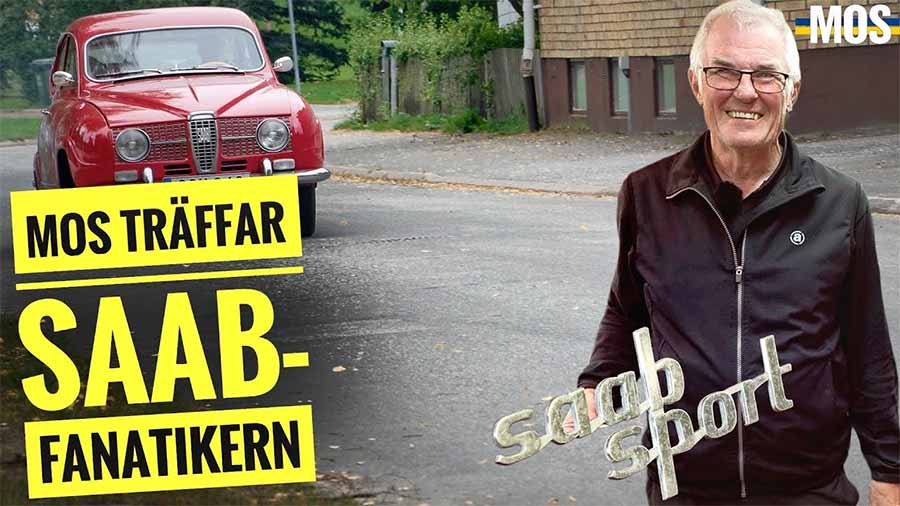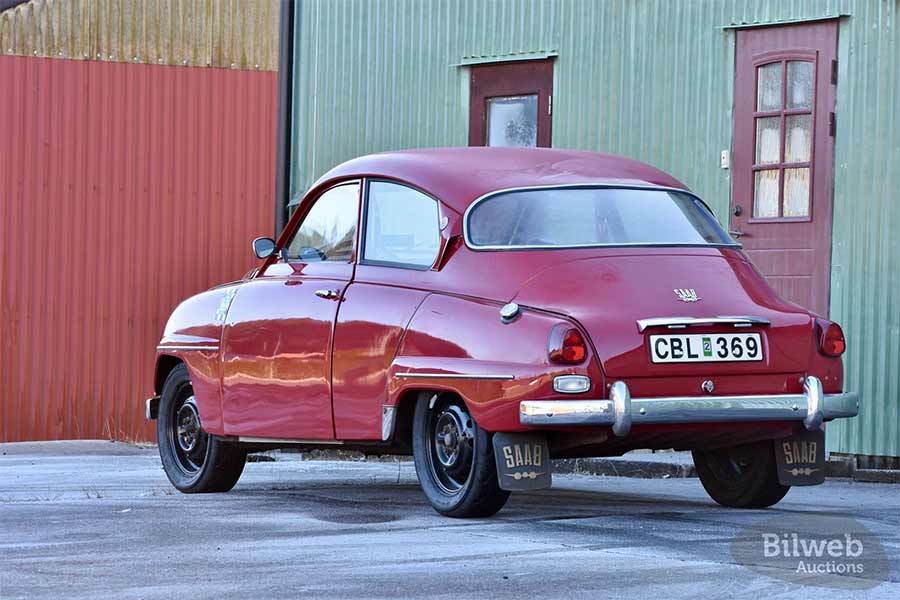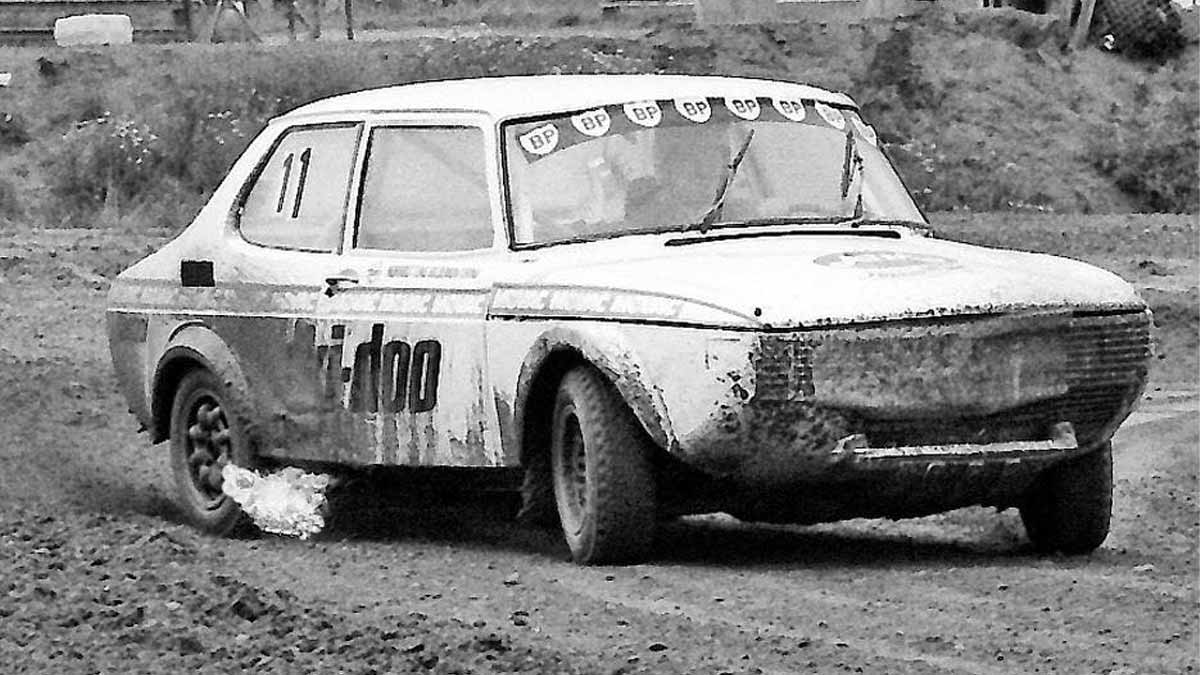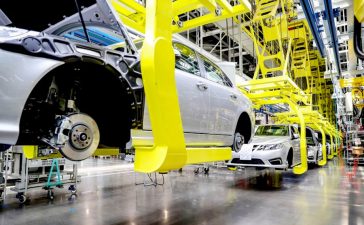There are restorations that save a car, and there are restorations that quietly safeguard an entire chapter of motorsport history. What Anders Jonsson has done with his Saab Sport belongs to the second category. Somewhere outside Umeå, in the same region where rallycross legend Ture Karlsson once terrorized winter stages and gravel circuits, a long-nose two-stroke Saab now stands as rolling proof that one enthusiast can carry a whole era forward.
The story starts more than three decades ago, when Anders was young enough to dream in rally pace notes and Saab two-stroke noise. He bought a tired Saab Sport around 33 years ago, already aware that these cars would not remain cheap curiosities for long. He began stockpiling anything that said “Sport” or “Monte Carlo” on it, tucking away parts before values and scarcity caught up. At that time, rally was everything for him—and his hero was a local driver with a reputation that reached far beyond Norrland: Ture Karlsson, “Karlsson på taket.”
Today, those roles have shifted. Ture is no longer just a name in old result lists; he is Anders’ friend and mentor, the man who taught him “almost everything” about Saabs. When the Sport finally fired up again after its total rebuild, Ture was there, listening to the crisp two-stroke idle that once carried him through forests and over frozen lakes. That moment, captured and shared on the Motorblog of Sweden YouTube channel, is the spine of this story.

What follows is not just a walk-around of a nice old Saab. It is a deep look at how one car, one mentor, and one patient owner can hold together the threads of Swedish rally history.
The student and the master: a Saab Sport built in Ture’s shadow
For Anders, Saab was never a casual interest. When he talks about his early years, rally sits at the center, and local heroes mattered far more than factory brochures. In Umeå, that meant Ture Karlsson – a driver whose name appears again and again in rally and rallycross results from the 1960s through the 1980s. While most people knew Ture from newspaper clippings or paddock gossip, Anders ended up learning the mechanical side directly from him.
He describes it simply: “Everything I know about wrenching on these cars, I’ve learned from him – or most of it, anyway.” That is not a casual statement. When someone like Ture, who built and raced wild V4s and turbo 99s with home-made four-wheel drive, starts teaching you two-stroke engines, you listen. Ture even came over to be present when the restored Saab Sport was started for the first time, an unspoken passing of the torch from driver to caretaker.
That dynamic shapes the car itself. Anders doesn’t treat this Sport as a museum object; he approaches it exactly as his mentor would have done: fix the weaknesses, understand the engineering, and only then worry about polish. The result feels like a competition car that just happens to be spotless.
A 33-year commitment: from battered Sport to bare shell
When Anders first saw the car, it was not an obvious candidate for a reference-grade restoration. It had lived a hard life, including at least one “little pirouette” that left it quite badly dented. Panels were buckled, and the overall impression was more “used up rally hack” than future showpiece. Many enthusiasts would have scavenged what they could and walked away.
Anders did the opposite. He stored the car for years, slowly gathering parts and waiting for the right moment to do it properly. The decision was clear even back then: these cars would become desirable, and he wanted to keep this one intact. When the restoration finally began, it was not a quick respray. The Sport went down to molecules, as Anders says – stripped to the last fastener.
Interestingly, the shell itself turned out to be better than expected. There was almost no rust in the usual Saab trouble spots, a minor miracle for a car this age and latitude. The problem was distortion rather than corrosion, so he ended up swapping several wings and straightening the metal instead of welding in half a new body. Underneath the dents, the car was sound.
The year matters too. This is a 1965 Saab Sport, one of those slightly quirky, short-run combinations Saab was so good at. It still carries details that only that model year got, like double hood latches with an extra safety catch that disappeared later because they cost money and added complexity. It is a tiny thing, but these small one-year-only touches are exactly what make this restoration so significant.
Inside the two-stroke: saving a fragile crankshaft and modernizing the heart
Anyone who knows Saab two-strokes also knows the horror stories: an engine that has slept for decades is carefully started, runs flawlessly for a few hundred or a thousand kilometers – and then the crankshaft destroys itself. Anders is painfully aware of that pattern, and he explains why.
On these engines, the crankshaft is a pressed assembly with ball bearings and aluminum cages. Over time, especially when the motor stands unused, you can get pitting and point corrosion in the bearing raceways. Add to that the fact that the aluminum ball cages age and become brittle. The combination is lethal. One small fracture or corrosion breakthrough, and the whole assembly fails in a very short time.
Knowing this, he never considered “just running it as is.” The crankshaft was sent to a specialist in Sandviken, someone who has made a name for himself rebuilding these units. The shaft was fully rebuilt with modern bearings, preserving the feel of the original engine while dramatically improving reliability. This is the difference between a car that sounds good in a static video and one that can actually be driven and enjoyed without constant fear of catastrophic failure.
Anders went through the rest of the engine with the same level of obsession. Every oil gallery was checked, cleaned and verified by hand with wire and compressed air until he was certain that flow would be unobstructed. All hoses and ignition leads were replaced, and anything age-sensitive was renewed. He wanted a motor that is not just clean on the outside, but fundamentally healthy on the inside, ready to do what Saab built it to do: rev hard and survive.
Oil tanks, triple carbs and early engineering that still feels advanced
Open the hood and the differences between a Saab Sport and a standard 1965 two-stroke become immediately obvious. A regular 65-model stands at around 42 horsepower. The Sport delivers 55 horsepower, a roughly 30 percent jump that transforms the car’s character. This is not a small bump; you feel it every time the revs climb.

One key feature is the separate oil tank and automatic lubrication system. You fill fuel in the regular filler, then pour two-stroke oil into a dedicated reservoir under the hood. A pump meters that oil into the engine, eliminating the need for pre-mixing. Saab put this into production as early as 1962 on the Sport, decades before similar ideas became common in the snowmobile world. For its time, this was a remarkably sophisticated way to handle two-stroke lubrication.
Then there is the induction system: three carburetors, one for each cylinder. On the early bull-nose Sports (’62–’64), each carb had its own throttle shaft and needed to be synchronized individually—a fiddly job that demanded patience. On the 1965–66 long-nose cars, Saab refined the system with a shared throttle shaft, making setup far less painful while keeping the performance benefits.
Anders’ car uses this later layout. It still requires care to adjust, but he notes that it is much more forgiving than the early triple-carb arrangement. His plan is to take the best pieces from two sets of manifolds and carburetors to eliminate play in the throttle shafts and improve idle stability. This is typical of the whole project: nothing is simply “good enough” if it can be brought closer to period-correct competition spec.
Vinyl, headrests and hidden storage: living inside a Saab Sport
Step into the car and the restoration philosophy follows you. The interior is as close to factory-fresh as a used cabin can realistically get, yet it carries the scars and material limitations of the period. The seats are trimmed in the classic red-and-grey vinyl and fabric combo, one of several color schemes Saab offered on these cars. Other combinations matched body colors – white cars with red vinyl and red cloth, blue cars with blue trim – but all shared one problem: the vinyl cracks.
Decades later, that cracked vinyl is the restorer’s nightmare. Very few upholstery shops in Sweden can supply anything close to the original grain and color, and sourcing correct material often means buying from overseas in large quantities. Anders solved this the old-fashioned way: he hoarded interiors over the years and built one good cabin out of several donor sets.
Details matter here. Only the passenger seat has a headrest, which is original, not a mistake. One explanation Anders has heard is wonderfully rally-specific: the driver should be able to lie back and rest between stages, while the co-driver keeps working. Whether or not that was Saab’s official reasoning, the detail underlines how competition thinking seeped into these cars.
There are storage pockets under the rear seat, capable of swallowing multiple bottles, and small touches like that give the Sport a dual personality: part rally tool, part clever Swedish family car. The steering wheel is a story on its own, a factory wooden rim wheel often mistaken for an Italian Nardi, fully restored by a specialist near Gävle known simply as “Ploppen.” He filled every crack, refinished the surface and polished it until it looked new.
The dashboard differs clearly from standard models too. The Sport features a rev counter and unique instrument layout, with a removable central plastic section on the long-nose cars. On earlier bull-nose models, the entire dash was metal and the instruments sat directly in the sheet metal. Even details like the shape of the ashtray and the glovebox handle signal that this is not a normal 96.
Chrome strips, four-bolt wheels and discs: what the bodywork really tells you
Walk around the exterior and you start to see how many cues Saab built into the Sport and Monte Carlo cars. The chrome mouldings along the doors and fenders are a signature of Saab’s sportier variants – Sport, Monte Carlo, GT 750, GT 850. On Anders’ car, they are present and correct, with double strips adding just a little extra drama to the profile.
Look closer at the wheels and you notice something that will confuse anyone used to later Saabs: four wheel bolts instead of five, and a larger center hole. That setup relates directly to the fact that the Sport had front disc brakes from 1962 onwards, a serious feature at a time when many competitors still relied on drums all round. Rear drums remain, but the front hardware puts the Sport in a different league from a braking perspective.
Anders refuses to fit hubcaps, partly out of personal taste and partly because no one ran hubcaps in rally. On competition cars, they would have become flying metal projectiles the first time the car hit a rut. The clean exposed steel wheels suit the car’s character perfectly.
Bumpers and grille are original, not reproduction. They carry light scratches and age marks, which Anders chose to keep rather than over-restoring them. The grille inserts with extra chrome bars are rare period accessories that add a subtle sense of motorsport theater without drifting into caricature.
Even the rear back-up lights tell a story: all Sports had them, as did US-market Saabs later, but standard domestic cars did not. For a Swedish buyer in the 1960s, that extra pair of white lenses signaled that this was something special.
Gearing, Monte Carlo comparisons and the way a Saab Sport moves
Ask Anders why he prefers the Sport to the closely related Monte Carlo, and the answer is immediate: final drive ratio. The Sport uses a 7:36 final drive specific to that model, while the Monte Carlo received the taller gearing that would later appear on V4 cars. Standard two-strokes, in turn, had an even shorter ratio.
The result is that the Monte Carlo can feel slightly overgeared with its high-revving two-stroke, whereas the Sport lands in a sweet spot. The engine stays in the power band more naturally, and the car feels more eager without becoming frantic. It is the kind of difference you only truly appreciate when driving these cars back-to-back, but on paper and in practice it explains much of the Sport’s reputation.
On the road, handling is exactly what made drivers like Ture so dangerous in underpowered machinery. Anders points out that the balance of these cars is outstanding, especially on the older bull-nose bodies that land almost perfectly flat after jumps. The long-nose version is a little more inclined to dive, and the later V4 cars more so, but the core traits remain: light nose, predictable rear, and a rack-and-pinion steering system that tells you exactly what the front wheels are doing.
That steering feel is not nostalgia; it is mechanical precision. Modern electric racks may be quicker, but they rarely communicate like this. On loose surfaces, that matters more than raw power, and it is one of the reasons drivers like Ture could win outright against cars with far more horsepower. In Anders’ hands today, the Sport retains that same ability: given enough speed and space, it still dances.
Parts hunting, period tuning and the wider Saab universe in one garage
The video doesn’t stop with the finished car. In a corner of the workshop sits another project: a V4 engine built to 1815 cc with Saab’s high-compression forged pistons, cross-flow heads and Weber carburetors. This is exactly the type of setup that factory drivers like Stig Blomqvist used in period, aimed at roughly 160 horsepower from what started life as a modest family engine.
Nearby are unused original Sport front silencers with internal tuned cones, not just perforated pipes. That kind of exhaust was unique to the Sport and shows how deeply Saab engineers understood two-stroke pulse tuning. It is not just a muffler; it is a power-shaping device.
Finding parts like these is not a matter of luck anymore. Anders is plugged into Saab circles and forums, knows who has what on their shelves, and understands how fast prices rise when a part is clearly Sport- or Monte Carlo-specific. Items like a clean fuel tank flap in the correct location or a rust-free rear quarter with no trim holes are small in isolation, but together they define whether a restoration feels authentic or improvised.
The fact that this Sport returned to the road after standing since the 1980s, passed inspection, and now does real kilometers again is perhaps the most important detail of all. It is not a static exhibit; it is a fully functional time capsule that can still put its suspension and steering to work, exactly as Saab intended.
Why this Saab Sport matters far beyond one Swedish garage
For Saab enthusiasts worldwide, stories like this one hit several nerves at once. There is the technical side: early oil-injection systems, triple carburetors, disc brakes, clever gearing, and competition-influenced details everywhere you look. There is the human side: a young enthusiast who buys a battered car, stores it for decades, and finally rebuilds it with the help of a local legend who once raced similar machinery in anger.
Most of all, there is continuity. Ture Karlsson’s world of snowbanks, studded tires and gravel roads could easily have faded into monochrome photos and old newspapers. Instead, it now lives on in a meticulously rebuilt Saab Sport that still smells of two-stroke oil and responds instantly to steering input. When Anders turns the key, the sound is not just mechanical noise – it is a direct connection to Swedish rally history.
This is exactly what makes the Saab community different. These are not show cars built for resale value or social media likes. They are machines kept alive by people who understand what they meant in their own time, and who are willing to invest years – or in this case, more than three decades – to make sure the story continues.
Somewhere on a quiet road outside Umeå, a red-and-grey Saab Sport runs again. Its engine has modern bearings, its bodywork is straighter than when it left Trollhättan, and its owner still hears the voice of his mentor in every mechanical decision. For anyone who cares about Saab, that is worth far more than trophies.











